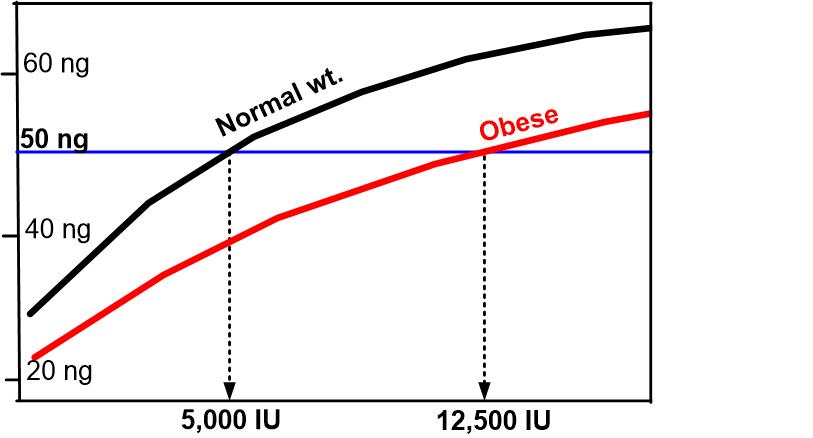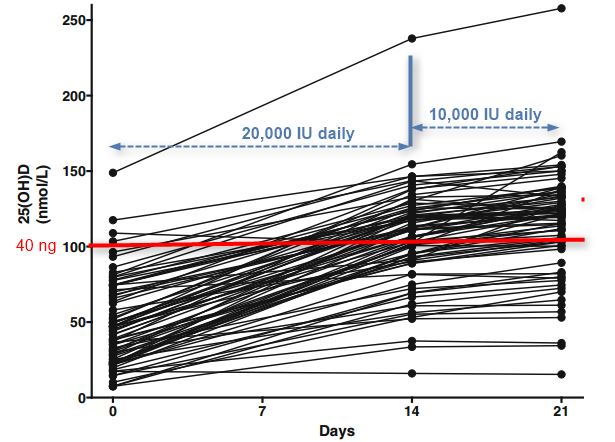Vitamin D Loading dose - 20,000 IU daily is not enough if obese, etc. (Cancer) great table and chart
Appropriate vitamin D loading regimen for patients with advanced lung cancer.
Nutr J. 2016 Oct 6;15(1):84.
Hoffer LJ1, Robitaille L2, Swinton N3, Agulnik J2,3, Cohen V2,3, Small D2,3, Pepe C2,3, Eintracht S4.
1Lady Davis Institute for Medical Research, McGill University and Jewish General Hospital, 3755 Cote Sainte Catherine, Montreal, QC H3T 1E2, Canada. l.hoffer@mcgill.ca.
2Lady Davis Institute for Medical Research, McGill University and Jewish General Hospital, 3755 Cote Sainte Catherine, Montreal, QC H3T 1E2, Canada.
3Pulmonary Oncology Peter Brojde Lung Cancer Centre, Jewish General Hospital, Montreal, Canada.
4Department of Diagnostic Medicine, Jewish General Hospital, Montreal, Canada.
 __Normal weight Obese (50 ng = 125)__
__Normal weight Obese (50 ng = 125)__
📄 Download the PDF from VitaminDWiki
Vitamin D response

Table 4 - Other Loading Dose studies
Table 4 Early time-point effects of oral vitamin D loading on plasma 25(OH)D concentrations of adults
|
First author, year |
Number |
Study population |
BMI |
Intervention |
Time point |
Mean 25(OH)D |
Range or SD |
|
[reference] |
concentration | ||||||
|
Weisman et al., 1986 [60] |
13 |
Elderly |
n.a. |
100,000 IU in one dose |
Baseline |
29 | |
|
14 days |
88 |
SD 14 | |||||
|
Ilahi et al., 2008 [54] |
30 |
Healthy volunteers |
27 |
100,00 IU in one dose |
Baseline |
27 | |
|
7-21 daysa |
105 |
SD 20 | |||||
|
Romagnoli, 2008 [56] |
8 |
Elderly nursing home |
n.a. |
300,000 IU in one dose |
Baseline |
33 | |
|
3 days |
120 |
n.a | |||||
|
7 days |
128 | ||||||
|
30 days |
152 | ||||||
|
Martineau et al., 2009 [55] |
56 |
Normalvolunteers |
n.a. |
100,000 IU vitamin D2 in one |
Baseline |
34b | |
|
dose |
7 days |
102 |
50-140 | ||||
|
11 |
Active tuberculosis |
n.a. |
100,000 IU vitamin D2 in one |
Baseline |
23b | ||
|
dose |
7 days |
133 |
70-250 | ||||
|
Cipriani et al., 2010 [61] |
48 |
Healthy volunteers |
24 |
600,000 IU in one dose |
Baseline |
35 | |
|
3 days |
193 |
SD ~68 | |||||
|
15 days |
193 | ||||||
|
30 days |
155 | ||||||
|
Amrein et al., 2011 57 |
12 |
Critically ill |
29 |
540,000 IU in one dose |
Baseline |
35 | |
|
3 days |
88 |
n.a. | |||||
|
7 days |
96 | ||||||
|
Rossini et al., 2012 [58] |
13 |
Elderly |
29 |
100,000 IU in one dose |
Baseline |
66 | |
|
7 days |
85 |
SD ~20 | |||||
|
14 days |
83 | ||||||
|
30 days |
84 | ||||||
|
12 |
29 |
300,000 IU in one dose |
Baseline |
64 | |||
|
7 days |
96 |
SD ~20 | |||||
|
14 days |
95 | ||||||
|
30 days |
86 | ||||||
|
12 |
29 |
600,000 IU in one dose |
Baseline |
54 | |||
|
7 days |
156 |
SD ~30 | |||||
|
14 days |
152 | ||||||
|
30 days |
129 | ||||||
|
Grossmann et al., 2012 59 |
15 |
Adults with cystic fibrosis |
18.5 |
250,000 IU in one dose |
Baseline |
76 | |
|
and acute illness |
7 days |
145 |
SD 34 | ||||
|
Roth et al., 2012 [62] |
34 |
Non-pregnant women |
n.a. |
70,000 IU in one dose |
Baseline |
54 | |
|
7 days |
79 |
~45-125 | |||||
|
14 days |
75 |
~40-140 | |||||
|
27 |
Pregnant women |
n.a. |
70,000 IU in one dose |
Baseline |
39 | ||
|
7 days |
67 |
~45-100 | |||||
|
14 days |
71 |
~50-120 | |||||
|
De Jong et al., 2013 63 |
14 |
Elderly acute hip fracture |
n.a. |
150,000 IU as 50,000 IU/day |
Baseline |
30 | |
|
for 3 days |
7 days |
81 |
47-108 | ||||
|
54 |
n.a. |
350,000 IU as 50,000 IU/day |
Baseline |
31 | |||
|
for 7 days |
7 days |
131 |
86-243 |
Table 4 Early time-point effects of oral vitamin D loading on plasma 25(OH)D concentrations of adults (Continued)
|
Drincic et al., 2013 [64] |
20 |
Obese |
38 |
10,000 IU per day |
Baseline |
58 | |
|
7 days |
80 |
n.a. | |||||
|
21 days |
106 | ||||||
|
Cantor, 2014 [65] |
18 |
Internal medicine |
n.a |
356,000 IU as 300,00 IU |
Baseline |
22 | |
|
patients |
followed by 4000 IU/day |
14 days |
102 |
50-202 | |||
|
32 |
n.a. |
206,000 IU as150,000 IU |
Baseline |
55 | |||
|
followed by 4000 IU/day |
14 days |
108 |
58-185 | ||||
|
Kearns et al., 2015 [66] |
14 |
Healthy volunteers |
24 |
250,000 IU in one dose |
Baseline |
41 | |
|
5 days |
102 |
70-149 | |||||
|
Oliveri et al., 2015 [67] |
11 |
Healthy volunteers |
22 |
100,000 IU in one dose |
Baseline |
41 |
SD 12 |
|
7 days |
105 | ||||||
|
11 |
21 |
100,000 IU vitamin D2 in one |
Baseline |
41 |
SD 28 | ||
|
dose |
7 days |
92 | |||||
|
Rousseau et al., 2015 [68] |
29 |
Healthy volunteers |
n.a. |
100,000 IU in one dose |
Baseline |
54 | |
|
7 days |
100 |
64-167 | |||||
|
20 |
Acute burn injury |
n.a. |
100,000 IU in one dose |
Baseline |
18 | ||
|
7 days |
48 |
12-84 | |||||
|
Tukvadze et al., 2015 [69] |
100 |
Active tuberculosis |
n.a. |
50,000 IU three times weekly |
Baseline |
35 | |
|
14 days |
175 |
n.a. | |||||
|
28 days |
225 | ||||||
|
Present study |
80 |
Lung cancer |
26 |
20,000 IU/day for 14 days |
Baseline |
48 | |
|
then 10,000 IU/day |
14 days |
106 |
16-238 | ||||
|
21 days |
116 |
15-258 |
BM! body mass index (kg/m2). 25(OH)D concentrations are expressed in nmol/L
aThe concentration peaked on day 7 and remained approximately constant throughout day 21
b Sum of 25(OH)D2 and 25(OH)D3
BACKGROUND:
Most patients attending cancer clinics have hypovitaminosis D. Correcting or preventing this abnormal condition could mitigate the emotional and physical complications of their disease, but clinical trials of vitamin D therapy in this setting are hindered by the unavailability of safe, effective and practical loading dose regimens.
METHODS:
In this single arm open-label pharmacokinetic trial, outpatients with advanced lung cancer consumed 20,000 IU vitamin D daily with the largest meal of the day for 14 days followed by 10,000 IU per day for a further 7 days . Plasma concentrations of 25-hydroxyvitamin D [25(OH)D], parathyroid hormone, calcium, vitamin C and C-reactive protein were measured on protocol days 0, 14 and 21, and serum vitamin D binding protein (VDBP) concentrations on days 0 and 21. As a secondary objective, preliminary information was obtained regarding clinical effects of rapid vitamin D loading on mood and symptoms by administering appropriate questionnaires two times at baseline and after 14 and 21 days of vitamin D therapy.
RESULTS:
Of the 91 patients enrolled in the study, 85 % had hypovitaminosis D and 41 % had hypovitaminosis C. Plasma VDBP concentrations were in the normal range. The vitamin D load increased the average plasma 25(OH)D concentration to 116?\ ± 34 nmol/L (mean ± SD); the median concentration was 122 nmol/L (interquartile range 103-134); VDBP concentrations did not change. Final plasma 25(OH)D concentrations were subnormal (<75 nmol/L) for 13 % of the patients and sub-target (<120 nmol/L) for 44 % of them. In most cases, subnormal and sub-target 25(OH)D concentrations were attributable to obesity and/or a low baseline 25(OH)D concentration. Mood and symptom scores did not change significantly throughout the 3-week protocol.
CONCLUSION:
Hypovitaminosis D and C are very common in outpatients with advanced lung cancer. A vitamin D load of 20,000 IU per day for 14 days failed to achieve the target concentration in 44 % of the participants in this tria l. These results suggest that a loading dose of 30,000 IU per day for 14 days would be safe and effective for patients who are obese or at risk of severe hypovitaminosis D . The preliminary nature of the study design, and the failure to achieve target 25(OH)D concentrations for a large proportion of the patients, do not allow any firm conclusion about the clinical effects of correcting hypovitaminosis D in this patient population. Nevertheless, no evidence was obtained that partial correction of hypovitaminosis D greatly improved mood, reduced distress or relieved cancer-related symptoms.
This trial was registered at clinicaltrials.gov as NCT01631526.
PMID: 27716304 DOI: 10.1186/s12937-016-0203-8
